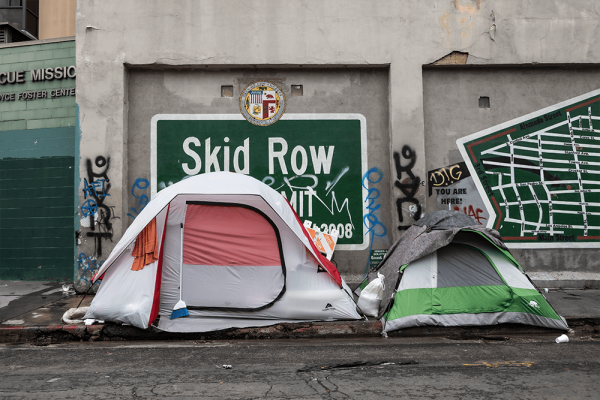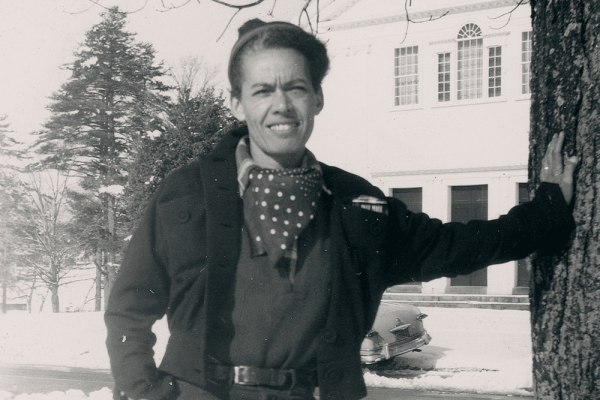It’s an overcast Saturday morning on Gladys Avenue in Skid Row — a 54-block area in downtown Los Angeles, home to one of the country’s most stable populations of people experiencing homelessness or housing insecurity.
Andrew Jiang of Alhambra, a city in western Los Angeles County, is there with a group of around 15 other volunteers with the Friars and Sisters Poor of Jesus Christ to serve chicken, rice, and vegetables to some 150 people living on Skid Row. On other days, a team of friars, nuns, and volunteers will walk block to block, distributing up to 400 sandwiches to more than 200 people.
“You get to know some of the people, develop a relationship,” Jiang, who has volunteered on Skid Row since 2018, said. “We try to do more than just hand out food. [We] talk and get to know their stories.”
In recent months, Jiang said he has noticed, among the usual crowd queuing in line, an upswing in the number of new faces, many of them from Central and South America. “Immigrants,” Jiang said. “In the last five years, I hadn’t met a single one down here, but now we meet at least a few every week.”
Running out of options
Skid Row is seen by many as the epicenter of the U.S.’s unhoused epidemic; it’s now home to an increasing number of migrant families from Colombia and Venezuela, being bused in by governors in states like Texas or making their way here to seek asylum.
According to The Los Angeles Times, “there are more than 100 families living there now, with more than 200 children,” many of whom are recent migrants. While the majority stay at a privately funded mission shelter that accepts families, a smaller number of these families now reside “in an array of large tents, pup tents and tarp shelters” along Towne Avenue, near Fourth Street, in what the Times called a “last resort for families that have run out of options.”
Giovanni, a Skid Row resident originally from Mexico, said more families are running out of options. (Sojourners is withholding Giovanni’s last name, at his request, due to his immigration status.)
“Whole families from South America are coming here, with their kids and everything,” he said. “They say the numbers are low, but I’ve seen them increasing.”
Daniela Ramírez is one of the mothers living on Skid Row. Braiding her daughter’s hair and sliding in pink-and-yellow hair clips as she sits on a street curb on Towne Avenue, Ramírez explained that she left a barrio in Barquisimeto, Venezuela, before making her way to the U.S.
Ramírez is one of hundreds of thousands of Venezuelans who have come to the U.S. over the last two years. Massive economic turmoil, along with a more general and systemic breakdown in civil and political rights — what Amnesty International calls a “complex humanitarian emergency that is devastating the country” — have pushed millions of Venezuelans to seek asylum or refuge across the Americas.
As immigrants arrive on buses that drop them on Skid Row, Giovanni said the newcomers join — or are already on — group text chains on apps such as GroupMe or WhatsApp, where they find information to help navigate Skid Row’s formidable, but informal, systems.
The Times reported that most women and children stay in hotels, apartments, and shelters in the area, with fathers sometimes staying on the streets. In some instances, groups of several women with their children will pool their resources and stay together in a shared hotel room or in mobile homes rented out by the city’s so-called “vanlords.” Current rent for these mobile homes can range from a few hundred dollars to more than $1,200 per month, Giovanni said.
“During the day, the kids go to school, and the women do what they can to make money — collect recyclable cans or wash windows,” he said. “Some have to do dubious things to get shelter and safe sleep … But it becomes worth it to keep your life together.”
While he is thankful for the volunteers who fed him and others that day and for reporting on the issue, Giovanni said he does not understand how the problem is not already more widely known.
“They have phones, they take pictures, they post videos on YouTube, stories on Instagram pleading for help,” he said, visibly agitated. “How do people not already know about these women, these families?” he asked incredulously. “Or, if they know, how do they know and do nothing?”
Giovanni blamed the media, the U.S. government, and local authorities and said, “More and more families are coming here and getting caught in Skid Row’s trap, its system.
“If we do nothing, they will really run out of options. They will never get out,” he said. “We have to do something.”
‘Christ crucified on the streets of Los Angeles.’
Sister Maria Goretti of the Spiritual Childhood said she and her fellow religious started doing something from the moment they first encountered migrant families on Skid Row two years ago.
Her order — the Sisters Poor of Jesus Christ — which has worked on Skid Row since 2018, was founded in 2001 by a Brazilian priest, Father Gilson Sobreiro, along with Sister Serva das Chagas. Sobreiro was so disturbed by the violence and poverty he saw in São Paulo, Brazil, that he began working with drug-addicted youth in the city. This led he and Sister Serva to found the new order, which has now spread to 14 countries, including Paraguay, France, Chile, Canada, Portugal, and the United States.
The order was invited by Los Angeles Archbishop José H. Gomez in 2018, and that calling led them to Skid Row, where over 4,400 of the county’s more than 75,000 unhoused people reside. Friars and sisters from the order go to Skid Row every Saturday and Tuesday to distribute free food and water, and to visit and pray with the unhoused.
Goretti joined the order in Brazil when she was 15 and worked in Brazil, Paraguay, and Kansas City, Mo., before coming to LA. When she first came to Skid Row, she said she was shocked by the destitution. “I never imagined Skid Row could exist in the United States,” she said. “It reminds me of the poverty I saw back home.”
But Goretti came to believe Skid Row — not beaches or palm-lined shopping streets — is the heart of the City of Angels and a stark reminder of its inherent inequalities and devastating disparities.
“Nobody talks about these people; they are not numbers,” she said. “They are destitute and destroyed people who are worthy of our love, compassion, and effort.”
That includes migrants such as Jennifer, a young mother from Peru who, in addition to having a 3-year-old, is pregnant with twins. Goretti said her order has been working with Jennifer, along with other pregnant women from South America on Skid Row, over the last several months. These women come to California, Goretti said, because they hear through informal networks that the state provides health care through Medi-Cal and special supplemental food and nutrition through a program for women, infants, and children called “WIC.” (Sojourners is withholding Jennifer’s last name, at her request, due to her immigration status.)
“In Peru, if you’re born poor, you die poor,” Goretti said. “But here in the United States, mothers like Jennifer know there’s a chance, a posibilidad.”
To help unhoused migrant mothers on Skid Row, Goretti said members of her order have had to learn what resources are available and how to connect individuals in need to them. In addition to Medi-Cal and WIC, the sisters also work with a person they called a “pro-life doctor” to provide prenatal care and counseling.
Rather than seeing Jennifer and other migrant mothers and families living on Skid Row as charity cases, Goretti said she is inspired, seeing the grace and courage of Christ in each of them. “Can you imagine being so brave and courageous to cross jungles and deserts and to risk life on the streets,” she asked, “all so your child can have a better life?
“Beyond your politics or social outlook, you have to see that Jesus is suffering in these women and children on the streets,” Goretti said. “They are Christ crucified on the streets of Los Angeles.”
Got something to say about what you're reading? We value your feedback!







